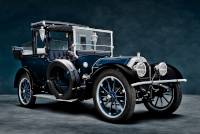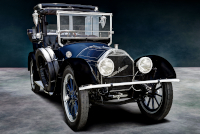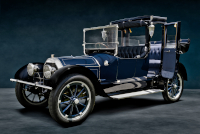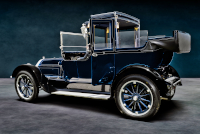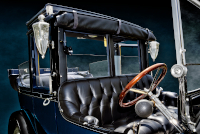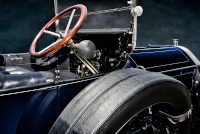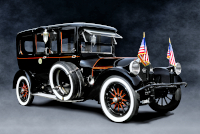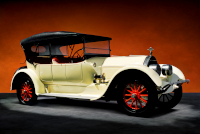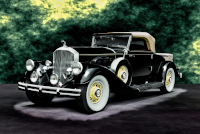Location:
Elegance at Hershey, 2019
Owner: Brian & Trish White | Apex, North Carolina
Prologue:
These closed-body Pierce-Arrow cars are the most exciting—in particular, the landau, landaulette, and vestibule bodies with their arches and hatches, elements more architectural than automotive. I'm reminded of a 1913 Model 38-C Vestibule Brougham that Michael Furman photographed for the Gateway Colorado Auto Museum, which appears in his book, "The Performing Art of the American Automobile." I envy him the gallery in that book, and fail to accomplish anything so glossy and detailed here. Even the eighth image I planned, a running gear portrait, became too much of a faff to bother publishing.
But I had been anxious to work on this vehicle since we saw the car in 2019, the final year for Hershey's amazing concours. Our gallery is an exercise in color consistency. In an uncontrolled environment, changing perspective changes the color. Changing distance changes the color. So in my mad-scientist photo lab, a lot of attention falls on the color and tone. Each image must look different, but of the same fictional studio. The results are subdued yet still colorful—nothing revolutionary, but I like the walk-around effect.
- - - - - - - - - -
► Image Source: Nikon D750 (24.3 MP)
References:
- Ralston, Marc. "Pierce-Arrow" A.S. Barnes & Co., Inc., San Diego, CA. 1980, page 86, 97, 231
- Ralston, Marc. "Pierce-Arrow, The Golden Age" Jostens Publications, Clarksville, TE. 1984, page 77
- Automobile Quarterly, Volume 28, Number 4, Fourth Quarter 1990, "Pierce-Arrow Specifications" The Kutztown Publishing Company, Inc., Kutztown, PA, page 106
- Stein, Jonathan A. with photographs by Michael Furman. "The Performing Art of the American Automobile" Coachbuilt Press, Philadelphia PA. 2011, page 28-33
- The New York Times Archives: March 28, 1935, page 15
- Wikipedia: Harris Charles Fahnestock
- Church of the Epiphany: Notes on Harris Fahnestock and his time in Washington DC.
- Schoolfield Country House: "The Fabulous Fahnestock Mansions Part 1: Townhouses" by Conrad Hanson outlines the history of the Fahnestock family in New York city.
Series 3 Pierce-Arrow cars bring subtle technical progress to an already industry-leading car. With the drop-frame chassis, body, and running boards lowered three inches, fuel delivery requires a pressurized system, as opposed to gravity feed. Pressurized fuel delivery means that the carburetor position can be elevated, facilitating maintenance. Again, a subtle change, but a Series 3 Pierce-Arrow is slightly lower, with a more modern fuel system. The drop-frame moniker refers to any chassis section set lower than the axles. These Pierce-Arrow cars use a double-drop-frame, meaning the central passenger compartment sits lower than the front and rear sections.
The town car landau configuration is a combination of standard Pierce-Arrow body offerings, a landau with a town car drivers compartment. But "standard" is not accurate for Pierce-Arrow, which built every car bespoke. These closed car configurations are true chauffeur vehicles, built to be run by hired hands.
The earliest known registration dates to 1926 and a lady named Helen, the sole daughter of Harris Charles Fahnestock and Margaret McKinley, both originally of Harrisburg, Pennsylvania. Helen married Dr. Clarence Gordon Campbell, but they divorced and she later married a lawyer, John Hubbard. The Pierce-Arrow's registration dates to her first marriage. Helen's father would not have seen this car, as he passed away in 1914.
The Fahnestock Influence on DC and New York: President Lincoln, Oppenheimer, and Philanthropy
Not to dwell on the upper class for the sake of citing impressive names, there are points worth mentioning that connect this car and its family to present-day life. Helen's father founded an investment banking firm, Fahnestock & Co. in 1881. That firm survives today in the form of Oppenheimer Holdings, which uses the Fahnestock date as its own founding date and lists Harris as its founder. Fahnestock would leave a mark on New York, contributing to many institutions, as well as the construction of the Cathedral of St. John the Divine. But Harris came to prosperity from humble beginnings.
Fahnestock's formal education ended at age 16 when he left to work for his father. According to the Church of the Epiphany of Washington DC, Fahnestock had been a bank teller in Harrisburg, and was brought to DC with the Jay Cooke and Company bank. Fahnestock's business acumen led to his advancement. He became a partner at the bank, worked with the Treasury Department, and served as a financial advisor to President Lincoln. Jay Cooke's personal influence prompted Fahnestock's conversion to faith, baptizing his first two children at Epiphany before being baptized with his wife. Cooke's philanthropic influence would then follow Fahnestock to New York. His turn toward faith paralleled his prosperity, which no doubt led his support of the cathedral on the upper west side, to say nothing of his support for more popular institutions of the arts and sciences.
The most notable present-day connections to Fahnestock are the Villard Houses, which comprise 451 to 457 Madison Avenue in midtown. The residences were constructed for Henry Villard, president of the Northern Pacific Railway, (incidentally one of Fahnestock's early New York business interests), but Villard's bankruptcy left the project incomplete. Fahnestock would acquire and finish three of the six unfinished town homes; his own was 457 Madison Avenue, where he resided until his death. The historic site is now home to the Municipal Art Society of New York (MAS), which is itself an aged institution. The urban planning and neighborhood advocacy group dates back to 1893.
Also somewhat prescient, north of New York City is the Clarence Fahnestock State Park, named for Harris' fourth son. The park sits on land donated by Dr. Ernest Fahnestock, the fifth son, in memory of his brother. Clarence had thought to build an estate on the Hudson next to Helen's. Instead, he volunteered to treat World War I patients in France, and died in 1918 during the pandemic.
Back in the city, Harris purchased a home at 24 West 51st Street during her marriage to Dr. Campbell. She divorced Campbell in the 1920s and married Hubbard in 1928, though he would predecease her shortly in 1935. At least one source notes that Helen exhibited her father's vigorous philanthropy, and if anything that spirit resonates with her late husband's parting gesture. The New York Times of March 28, 1935 reports that John Hubbard, lawyer and former treasurer of the International Banking Corporation, donated $1,140,000 of his net $1,423,171 estate to public institutions. Much can be said about the 1% discussion today, but the story of the Fahnestock family underscores how new era wealth acted in the public interest.
Others have formed more detailed commentary of this variety, that the barons of the early 20th century did not consolidate wealth for its own sake, but instead used that wealth to build the country. From our vantage, we cannot know every personal detail of the names associated with these old cars, pick apart their biases or judge their character to any accurate degree. But accounts that point us to charity and the sensitivity of social improvement do make holding on to material possessions like this stately landau more meaningful as a reminder of those who gave back.
Motor: 6,795 cc (414 cubic inch) straight 6-cylinder | 101.6 mm x 139.7 mm (4" x 5½")
Valvetrain: T-head, dual-valve, dual ignition
Aspiration: single updraft carburetor
Power: 38 rated horsepower @ 2,000 rpm
Drivetrain: 4-speed manual transmission, leather-faced cone clutch in oil, rear-wheel drive
Front Suspension: drop-forged I-beam axle, special heat-treated steel, with semi-elliptic leaf springs
Rear Suspension: live axle with three-quarter-elliptic leaf springs
Architecture: steel channel-section double-drop frame, cast aluminum body
Kerb Weight: 1,995.8 kg (4,400 lbs)
Wheelbase: 3,403.6 mm (134 inches)
Etymology:
The Model 38 takes its designation from the rated horsepower (not actual) of its 6-cylinder motor. The '-3' designation identifies the car as part of Series 3 production. The change to series nomenclature began in 1913 with the Model 38-C (which replaced the 36-UU), the Model 48-B (which replaced the 48-SS), and the Model 66-A (which replaced the 66-QQ). The new letters are superficial; they ascend from the least powerful, least expensive cars to the most powerful, most expensive cars. The '-#' convention began in 1914 with Series 2. Note that Series 3 debuted in June of 1914, and ran through February of 1916. So while the letter designation is unnecessary, the series number is not, as series do not correspond to calendar years.
Marc Ralston notes that body style combinations resulted in no fewer than 54 different styles (perhaps as many as 60). The Town Car Landau is one such variation, beginning with a landau body—one of the standard styles—but with a town car drivers compartment. Ralston's 1984 pictorial lists a known town car #36308, which may be this same example.
Figures:
Ralston cites total Pierce-Arrow Series 3 production at 3,100 cars, which spans the 38-C-3, 48-B-3, and 66-A-3. Estimated figures for the 38-C-3 across the Series 3 timeframe (June 1914 to February 1916) total 1,650 cars, more than half of all production.
Value:
The original price for this Town Car Landau in 1915 would reach the top end of the Model 38-C-3 range at $5,350.
Traps and Hatches: Describing the Landau Style
The landau section hinges downward while the roof hatch flips forward over the entry, creating a strange loggia of sorts. The compartment is a moving parlor with a quilted cloth sofa fitted into the back, open to the sun. A dome light with decorative glass keeps the compartment cozy when closed. Our interior portrait also shows a jump seat for an extra passenger, along with parasol and footrest.
Conducting matters of driving, the chauffeur sits on a quilted leather seat, better for weather resistance, and in this case receives the benefit of a roll-top hood. Note the glass partition between compartments, and the horn placed close to the driver's right ear. Two spare tyres block the driver's right-side door, which is typical for Pierce-Arrow—both the driving position and the practice of rendering the door useless. Access to trunk stowage at the tail was more important. Pierce-Arrow cars were built to run, and being so capable of covering long distances, the comfort and accommodation of their owners took priority over the driver's operating accessories.
German Touch: Lantern Style and Source on the Pierce-Arrow Motorcar
The prominent lanterns on either side of the passenger compartment are double-cut glass in German silver sconces. Pierce-Arrow first used this style in 1911 and would stick with it until the final limousine-style cars in 1919. Earlier lantern styles differed in material and finish.
Barrel Lights: New York Style Lights on the Fahnestock New York Landau
While they are not properly representative of Pierce-Arrow, I do like the look of these headlamps on their separate light bar. Introduced in 1914 and immediately popular with customers, the integrated headlamp would remain a Pierce-Arrow option until 1932. The company's reluctance to make the advance standard, even in the face of its popularity, underscores their staunch conservatism. Few customers didn't elect for integrated headlamps, though these nickel era cars look fantastic either way. The "Pierce-Arrow" plate on the radiator is another rarity, most often written as "Pierce" rather than the full name. Here, the script is less fancifully cursive; it is condensed and modernized.
Last Updated: Mar 26, 2025

